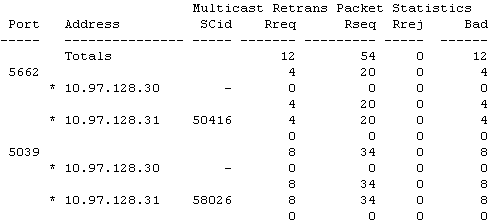Multicast Retransmit Statistics
Sending Rendezvous daemon process instances retransmit missed packets upon request from receiving Rendezvous daemons. This table displays statistics related to those retransmission requests. For statistics concerning the actual retransmitted packets, see Multicast Data Statistics—in particular, the Rdata and Rbytes columns.
The Rreq column of this table counts point-to-point packets. In contrast, the actual retransmitted data packets use the same protocol (multicast or broadcast) as the original data packets that they recapitulate (as do the rejection notices in the Rrej column).
|
Warning |
In switched Ethernet environments point-to-point packets remain invisible to In some switched networks, you can disable switching behavior—for example, by setting one port to diagnostic mode, or by using a diagnostic utility. This tactic can yield the full stream of point-to-point packets in a limited portion of the network; run |
Multicast Retransmit Packet Statistics shows a multicast retransmit table (from rvtrace -addrinfo). The text below introduces important concepts. Multicast Retransmit Packet Statistics—Column Headings describes the columns in detail.
Figure 152: Multicast Retransmit Packet Statistics

The first row (immediately after the table and column headings) is a network total row; the word Totals in the Address column is a visual cue. This row shows the grand total of packets related to retransmission detected on the network during the interval.
The remaining rows display more fine-grained information about those packets—grouping them by UDP service, and destination or source IP address.
The second row in Multicast Retransmit Packet Statistics is a port subtotal row—its columns subtotal the statistics over the subsequent destination and source rows which it governs (until the next port subtotal row).
A number in the Port column indicates the UDP service for its row, and the group of rows that follow it. A blank in this column means that the row has the same port as the row above, and is part of the same subtotal group. Notice how the pattern of numbers and blanks in the Port column visually indicates the subtotal groups.
For each IP address with retransmission request activity, this table contains a destination row and a source row—always paired in that order. An * and an IP address (in the Address column) flags a row as a destination row. A blank (space characters) flags a row as a source row. The address in the destination row also applies to the source row that immediately follows it.
This table displays each packet twice—once in a destination row, and once in a source row.
In each statistical column, the number in the port subtotal row is equal to the sum of the values in the destination rows, which is also equal to the sum of the values in the source rows.
In many networks it is possible to match the numbers in the source row for one IP address against the numbers in the destination row for another IP address. From this information you can deduce which Rendezvous daemons are missing packets and requesting retransmissions.
|
Column |
Description |
|
In port subtotal rows, this column contains a UDP port number indicating the Rendezvous service for the group of rows that it begins. In destination and source rows this column is blank; the service in the nearest preceding port subtotal row governs the destination and source rows below it. |
|
|
* |
Asterisk ( Blank in this column indicates a source row. |
|
In destination rows this column shows the destination IP address of retransmission request packets (that is, the Rendezvous daemon that originally sent data packets). In source rows this column shows the IP address from which retransmission request or rejection packets originate (that is, the Rendezvous daemon that missed receiving data packets). In network total rows, this column contains the word |
|
|
Service communication ID. In destination rows this column differentiates the destination ID of retransmission request packets (that is, the Rendezvous daemon that originally sent data packets). In source rows this column is blank. |
|
|
Retransmission requests. This column displays the number of packets that contain retransmission requests. Each request packet counts separately, even if several request packets specify the same data packet numbers for retransmission. For example, if two daemons each request retransmission of the data packets numbered 121–125, and a third daemon requests retransmission of the data packets numbered 100–144, then |
|
|
Retransmission sequence numbers. Each retransmission request packet can solicit one or more data packets for retransmission. This column sums the number of data packets for which retransmission is requested over the request packets (as counted in the Rreq column). If some data packets are requested several times, each data packet counts separately each time it is requested. For example, if three daemons request retransmission of data packets numbered 121–125, then the For more information, see Diagnoses. |
|
|
Retransmission rejection notices. Although Rendezvous daemons comply with retransmission requests whenever possible, sometimes the requested packets are no longer available. This column displays the number of packets that contain retransmission rejections. (Daemons send these rejection notices in multicast packets.) |
|
|
Bad packets. This column shows the number of packets that lack UDP checksums, or are corrupt in some other way. Warning See Bad Packets. |